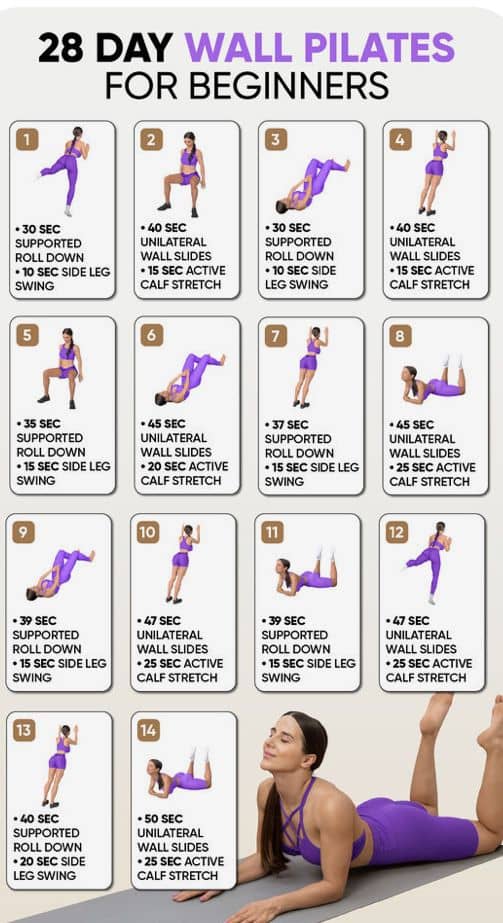Introduction
If you’ve been searching for a gentle yet incredibly effective workout routine to strengthen your core, improve flexibility, and support overall wellness, Wall Pilates might be exactly what you need. As a low-impact, full-body approach to fitness, Pilates can help you develop lean muscles, enhance posture, and boost balance—without overstraining your joints.
In this article, we’ll delve into a 28-day Wall Pilates program specifically designed for beginners. This routine incorporates key Pilates principles, while offering the support (literally!) of a wall to guide you through each movement. From supported roll-downs to unilateral wall slides, we’ll break down everything you need to know about correct form, progression, and ways to maximize results. Whether you’re just starting your fitness journey or looking for a gentle routine that still delivers serious core benefits, this plan is here to help.
Disclaimer: Always consult a healthcare or fitness professional before starting any new exercise regimen, especially if you have existing medical conditions or concerns. This article is for informational purposes and does not replace professional medical advice.
Why Choose Wall Pilates?
- Beginner-Friendly: Traditional Pilates can sometimes feel intimidating for newcomers, especially when it comes to maintaining proper alignment. The wall provides extra support and stability to help you nail the fundamental movements without strain or confusion.
- Low-Impact on Joints: Pilates exercises generally involve slow, controlled movements, making them perfect for individuals with joint issues or those returning to exercise after a long break.
- Core Engagement: Pilates is renowned for its emphasis on “the powerhouse,” aka your core muscles. Strengthening these muscles can promote better posture and help alleviate lower back pain.
- Versatility: You only need a few feet of clear wall space. It’s an accessible, minimal-equipment method of working out—perfect if you have limited space or no time to commute to a gym.
- Progressive Results: Over the course of 28 days, your body will gradually adapt to the exercises. This routine introduces slight progressions in intensity and duration to help you continuously challenge your muscles without risking injury.
Pilates Principles to Keep in Mind
Before diving into the 28-day schedule, it’s helpful to understand a few core Pilates principles:
- Concentration: Focus on your breath, body alignment, and the specific muscles you are engaging with each exercise.
- Control: Move with intention, avoiding jerky or rapid motions. This principle helps reduce injury risk.
- Centering: Emphasize core engagement, which anchors all your movements.
- Precision: Proper form is key. Quality of movement often matters more than the number of repetitions.
- Breath: In Pilates, the breath guides your movements. Generally, you’ll inhale to prepare and exhale during the exertion phase of a movement.
- Flow: Strive for fluid transitions between exercises to maintain stability and muscle engagement.
Your 28-Day Wall Pilates Plan Overview
Below is a day-by-day breakdown of the exercises found in the image. The program is structured so that each day focuses on a variation of two core Pilates-inspired moves. The times or reps progressively increase over the 28 days to keep your muscles challenged.
- Supported Roll Down
- Unilateral Wall Slides
- Side Leg Swings
- Active Calf Stretch
Though each day features slightly different timed intervals, the overall structure remains the same:
- Odd-Numbered Days emphasize Supported Roll Downs paired with Side Leg Swings.
- Even-Numbered Days emphasize Unilateral Wall Slides paired with Active Calf Stretches.
Let’s break down the exercises and then see how they fit into each day of the 28-day routine.
Exercise Breakdown
1. Supported Roll Down
- Setup: Stand with your back against the wall, feet hip-distance apart, about 6-12 inches (15-30 cm) away from the wall. Your tailbone, lower back, and shoulders should all make contact with the wall if comfortably possible.
- Movement:
- Inhale to prepare.
- Exhale as you gently roll your spine down, vertebra by vertebra, bringing your chin toward your chest.
- Let your arms drape in front of you as you move downward. Keep the back of your pelvis lightly in contact with the wall.
- Only roll down as far as comfortable—ideally until your hands are near your shins or ankles.
- Inhale at the bottom, then exhale as you slowly roll back up to standing, restacking your spine.
- Key Points: Move slowly, keeping your core engaged. Focus on the controlled articulation of your spine. You should feel a gentle stretch in your hamstrings and a release in your lower back.
2. Unilateral Wall Slides
- Setup: Stand with one shoulder to the wall at arm’s length. Your feet can be slightly wider than hip-distance if needed for balance.
- Movement:
- Place one hand against the wall (about shoulder height) for balance.
- Slowly squat down by bending your knees while keeping your back neutral.
- As you squat, the sliding side (the leg farthest from the wall) can move slightly outward, maintaining alignment.
- Press through your heels to return to standing.
- Unilateral Focus: You can shift focus to the “outer” leg or the “inner” leg by adjusting how you distribute your weight. Repeat the set number of seconds on one side, then switch sides.
- Key Points: Keep your knees aligned over your toes. Engage your glutes and core to keep your torso upright.
3. Side Leg Swings
- Setup: Stand sideways to the wall, placing one hand on it for stability.
- Movement:
- Keep the standing leg slightly bent and core engaged.
- Swing the outer leg forward and backward in a controlled manner, never letting momentum take over completely.
- Maintain a tall spine and keep your gaze forward.
- Key Points: Use your core to control the leg’s movement. Avoid over-arching your lower back. The swing should be gentle, focusing on hip mobility and leg strength.
4. Active Calf Stretch
- Setup: Face the wall with your hands at chest height, palms resting against the wall.
- Movement:
- Step one foot back, keeping the heel pressed into the floor.
- Bend your front knee and lean into the stretch, feeling the tension in your back calf.
- For an active variation, alternate gently lifting and lowering the heel of the back foot.
- Maintain a straight back leg as much as comfortable.
- Key Points: Keep your hips squared toward the wall. Focus on controlled movement. Alternate sides when indicated by your schedule.
Day-by-Day Schedule
Below is a sample layout of how the exercises progress over the first 14 days. The next 14 days often repeat the sequence, extending the time or making slight adjustments to keep challenging you.
- Day 1: 30 sec Supported Roll Down + 10 sec Side Leg Swing
- Day 2: 40 sec Unilateral Wall Slides + 15 sec Active Calf Stretch
- Day 3: 30 sec Supported Roll Down + 10 sec Side Leg Swing
- Day 4: 40 sec Unilateral Wall Slides + 15 sec Active Calf Stretch
- Day 5: 35 sec Supported Roll Down + 15 sec Side Leg Swing
- Day 6: 45 sec Unilateral Wall Slides + 20 sec Active Calf Stretch
- Day 7: 37 sec Supported Roll Down + 15 sec Side Leg Swing
- Day 8: 45 sec Unilateral Wall Slides + 25 sec Active Calf Stretch
- Day 9: 39 sec Supported Roll Down + 15 sec Side Leg Swing
- Day 10: 47 sec Unilateral Wall Slides + 20 sec Active Calf Stretch
- Day 11: 39 sec Supported Roll Down + 15 sec Side Leg Swing
- Day 12: 47 sec Unilateral Wall Slides + 25 sec Active Calf Stretch
- Day 13: 40 sec Supported Roll Down + 20 sec Side Leg Swing
- Day 14: 50 sec Unilateral Wall Slides + 25 sec Active Calf Stretch
For Days 15-28, you can:
- Repeat the 14-day cycle, gradually adding 5-10 seconds (or 2-5 reps) to each exercise each time they appear.
- Maintain the same time intervals if you prefer a consistent routine, focusing on refining technique.
As the sequence progresses, these incremental increases in time (or repetitions) help prevent fitness plateaus and keep your core muscles consistently challenged.
Detailed Guide for Each Day
To ensure you get the most out of each session, here’s a more in-depth look at how you might structure your daily workout:
Day 1: (30 sec Supported Roll Down, 10 sec Side Leg Swing)
- Warm-Up (2–3 minutes)
- March in place or do gentle shoulder rolls to get the blood flowing.
- Practice slow, deep breathing to center yourself.
- Supported Roll Down (30 seconds)
- Roll down slowly, focusing on your breath.
- Complete as many controlled roll downs within that 30-second interval as comfortable.
- Rest briefly if needed.
- Side Leg Swing (10 seconds per leg)
- Stand side-on to the wall, using it for support.
- Gently swing the outside leg forward and back for 10 seconds, focusing on controlled movement.
- Switch to the other side for another 10 seconds.
- Cooldown (1 minute)
- Take a few deep breaths, stretching your arms overhead.
- Gently rotate your torso side to side.
Day 2: (40 sec Unilateral Wall Slides, 15 sec Active Calf Stretch)
- Warm-Up (2–3 minutes)
- Gentle side steps or a slow walk in place.
- Light shoulder rolls to loosen the upper body.
- Unilateral Wall Slides (40 seconds total; 20 seconds each side)
- Align one hand against the wall at shoulder height.
- Slowly squat down, then return to standing.
- Keep the knee tracking over the second toe.
- After 20 seconds on one side, switch to the other side.
- Active Calf Stretch (15 seconds each side)
- Place both hands on the wall, step one foot back.
- Bend your front knee slightly and lean in.
- Gently lift and lower the heel of your back foot.
- Switch sides after 15 seconds.
- Cooldown (1 minute)
- Roll your shoulders, inhaling deeply and exhaling fully.
Day 3: (30 sec Supported Roll Down, 10 sec Side Leg Swing)
- Repeat the same structure from Day 1 but aim to improve form and mind-muscle connection.
- If you feel comfortable, try rolling down a little farther, provided it doesn’t strain your back or hamstrings.
Day 4: (40 sec Unilateral Wall Slides, 15 sec Active Calf Stretch)
- Repeat the same structure from Day 2.
- Focus on going a bit deeper in the squat if you’re able, and keep the movements smooth and controlled.
- Engage your core to protect your lower back.
Day 5: (35 sec Supported Roll Down, 15 sec Side Leg Swing)
- You’ll notice an increase in time for both exercises (or an increase in the time spent on side leg swings).
- Maintain your alignment and core engagement throughout.
Day 6: (45 sec Unilateral Wall Slides, 20 sec Active Calf Stretch)
- A more extended interval for the slides means you may perform more reps or simply hold the bottom of the squat a bit longer.
- Keep your movements controlled to prevent knee strain.
Day 7: (37 sec Supported Roll Down, 15 sec Side Leg Swing)
- Slight variations in timing keep the program from becoming monotonous while gently increasing the challenge.
Day 8: (45 sec Unilateral Wall Slides, 25 sec Active Calf Stretch)
- When doing calf stretches for longer periods, remember to breathe steadily and avoid bouncing. Keep it “active” by gently lifting your heel.
Day 9: (39 sec Supported Roll Down, 15 sec Side Leg Swing)
- Continue refining your roll-down technique. See if you can feel each vertebra articulate as you go down and up.
Day 10: (47 sec Unilateral Wall Slides, 20 sec Active Calf Stretch)
- As you approach nearly a minute of wall slides, pace yourself. Slow, methodical squats can significantly help build leg strength and stability.
Day 11: (39 sec Supported Roll Down, 15 sec Side Leg Swing)
- Your body is likely acclimating to these movements now. This is a good time to ensure you’re engaging your lower abs and pelvic floor.
Day 12: (47 sec Unilateral Wall Slides, 25 sec Active Calf Stretch)
- With a longer interval for calf stretches, focus on the mind-muscle connection in your calves. This helps reduce muscle tightness and potential cramping.
Day 13: (40 sec Supported Roll Down, 20 sec Side Leg Swing)
- Add 5 seconds to your side leg swings if it feels comfortable. Keep the swings gentle, focusing on hip mobility and stability.
Day 14: (50 sec Unilateral Wall Slides, 25 sec Active Calf Stretch)
- Congratulations! You’re at the halfway mark. At 50 seconds, the unilateral wall slides will challenge your endurance.
- After this day, decide whether you want to repeat the cycle (Days 1–14) or continue adjusting duration.
Tips for Success
- Listen to Your Body: If you feel pain or discomfort, consider reducing the range of motion or taking a brief pause.
- Modify as Needed: Some people may need to decrease their range of motion or use more support. It’s always better to maintain proper form than to push too far too soon.
- Stay Consistent: Consistency is key for seeing results in a 28-day challenge. Even 5-10 minutes a day can yield improvements in strength and flexibility over time.
- Hydrate and Fuel Properly: Drinking enough water and eating balanced meals can support better performance and recovery.
- Track Your Progress: Consider journaling how you feel each day—energy levels, any soreness, improvements in flexibility, etc. This helps keep you motivated and accountable.
- Combine with Light Cardio: If your schedule allows, add short walks or light cycling sessions to complement your Pilates routine.
The Benefits You Can Expect
- Improved Core Strength: Regular roll-downs and controlled squats (via wall slides) challenge your core to stabilize the spine.
- Better Posture: Pilates-based exercises emphasize spinal alignment, which can lead to reduced slouching.
- Enhanced Flexibility: Side leg swings and calf stretches gradually increase your range of motion in the hips and ankles.
- Toned Muscles: Unilateral movements target smaller stabilizing muscles that often get neglected in traditional workouts.
- Reduced Stress: Mindful breathing and concentration can have a calming effect, lowering stress levels.
Frequently Asked Questions
1. How much space do I need for Wall Pilates?
You only need a patch of wall wide enough for you to stand or lie alongside it. Ideally, an area where you can fully extend your arms and legs without obstruction.
2. Do I need any equipment?
No specialized equipment is necessary. Comfortable clothes, a yoga mat (for your feet or lower back comfort), and sturdy footwear (or bare feet) can enhance your experience.
3. Can I do this routine if I have joint issues?
Pilates is generally low-impact, but always consult your physician if you have chronic pain or injury. They can guide you on necessary modifications.
4. What if I can’t keep up with the time intervals?
Feel free to break it down or reduce the time. For example, if a 40-second interval is too long, do two 20-second intervals with a short break in between.
5. Is it normal to feel sore the next day?
Yes, mild to moderate muscle soreness can be expected, especially if you’re new to Pilates. This is a sign your muscles are adapting.
Safety and Google AdSense Compliance
- Content Policy Adherence: This article provides information on exercise routines in a respectful, non-discriminatory manner, suitable for a general audience.
- Medical Disclaimer: Remember that this article does not replace professional medical advice. Always check with your healthcare provider before starting any new exercise regimen.
- Family-Friendly and Inclusive Language: The instructions above are appropriate for all ages and fitness levels (barring any underlying medical concerns), making them family-friendly.
Conclusion
Embarking on this 28-Day Wall Pilates for Beginners journey can be a transformative step toward improving strength, posture, and overall well-being. By leveraging the stability of a wall, you’ll be able to practice essential Pilates principles—control, precision, breath, and flow—while reducing the risk of injury. Over the course of these four weeks, you’ll notice gradual improvements in core engagement, flexibility, and body awareness that can enhance your daily life in countless ways.
Ready to get started? Set aside a few minutes each day to follow the plan outlined above. Remember to stay patient, listen to your body, and celebrate the small victories along the way. With consistent effort and a mindful approach, this Wall Pilates program can become a cornerstone of a healthier, happier lifestyle.
Share Your Progress: If you find yourself loving this routine or have any helpful tips to add, feel free to share your experiences in the comments. Pilates is a journey, and every body is unique—your perspective might just motivate someone else to take that first step toward a stronger core and healthier body!
Author’s Note: Always listen to your body and consult a professional if you experience persistent pain or discomfort. Stay active, stay safe, and enjoy the process of building a stronger, more resilient you!










